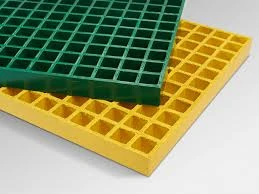loading...
- No. 9, Xingyuan South Street, Dongwaihuan Road, Zaoqiang County, Hengshui, Hebei, China
- admin@zjcomposites.com
- +86 15097380338
- Welcome to visit our website!
Fiberglass Grating Solutions for Durable and Lightweight Walkways and Platforms
The Benefits of Walkway Fiberglass Grating A Sustainable and Durable Solution
In today's construction and industrial sectors, the importance of utilizing materials that are not only durable but also sustainable cannot be overstated. One material that has garnered significant attention is fiberglass grating, particularly in the form of walkway systems. This innovative solution is increasingly being employed for a variety of applications ranging from pedestrian walkways to heavy industrial platforms. In this article, we will explore the benefits of walkway fiberglass grating, emphasizing its durability, safety, and environmental sustainability.
Exceptional Durability
Fiberglass grating is renowned for its exceptional durability. Made from a composite of fiberglass reinforced plastic (FRP), it exhibits a high tensile strength that makes it ideal for a range of applications. Unlike traditional materials such as wood or metal, fiberglass is resistant to corrosion, rust, and decay. This makes it a preferred choice in environments where moisture, chemicals, or extreme weather are prevalent. For instance, in wastewater treatment plants or chemical processing facilities, the longevity of fiberglass grating drastically reduces the need for frequent replacements and maintenance, resulting in significant cost savings.
Enhanced Safety Features
Safety is a paramount concern in any walkway design, and fiberglass grating excels in this regard. It is available in various slip-resistant patterns, providing better traction compared to smooth surfaces. This feature is particularly beneficial in wet or oily environments, significantly reducing the risk of slips and falls. Additionally, the open-grid design of fiberglass grating allows for excellent drainage, preventing the accumulation of water or debris that could pose a hazard to pedestrians.
Moreover, fiberglass grating is non-conductive, making it a safer choice in electrical installations or areas with high-voltage equipment. This property, combined with its lightweight nature, makes fiberglass grating easy to handle and install without compromising structural integrity.
walkway fiberglass grating

Environmental Sustainability
One of the most compelling reasons to consider walkway fiberglass grating is its environmental sustainability. The production process of fiberglass involves less energy compared to the production of traditional materials, such as steel or concrete. Additionally, fiberglass is fully recyclable; at the end of its life cycle, it can be repurposed rather than ending up in a landfill.
Using fiberglass grating contributes to greener construction practices. The material's longevity and reduced maintenance requirements mean that less material is consumed over time. Moreover, the reduction in the need for chemical treatments to prevent deterioration further minimizes the environmental impact associated with maintenance.
Aesthetic Versatility
Fiberglass grating is not only functional but also aesthetically versatile. It comes in various colors and can be customized to fit the specific design requirements of different projects. This allows architects and designers to maintain the visual appeal of their projects while benefiting from the mechanical properties of fiberglass. Whether it’s a modern industrial setting or a scenic outdoor walkway, fiberglass grating can seamlessly integrate into the design.
Conclusion
In conclusion, walkway fiberglass grating offers a multitude of benefits that make it a premier choice for both industrial and commercial applications. Its durability ensures a long life with minimal maintenance, while its safety features provide peace of mind for users. Furthermore, the environmental sustainability of fiberglass grating aligns with modern construction practices aiming for sustainability. Lastly, its versatility in design allows for both function and aesthetic appeal, making it a highly valuable material in today’s construction landscape. As industries continue to evolve, embracing innovative materials such as fiberglass grating becomes not just a trend, but a necessity for building a safer and more sustainable future.
-
The Rise of FRP Profiles: Strong, Lightweight, and Built to LastNewsJul.14,2025
-
SMC Panel Tanks: A Modern Water Storage Solution for All EnvironmentsNewsJul.14,2025
-
GRP Grating: A Modern Solution for Safe and Durable Access SystemsNewsJul.14,2025
-
Galvanized Steel Water Tanks: Durable, Reliable, and Ready for UseNewsJul.14,2025
-
FRP Mini Mesh Grating: The Safer, Smarter Flooring SolutionNewsJul.14,2025
-
Exploring FRP Vessels: Durable Solutions for Modern Fluid HandlingNewsJul.14,2025
-
GRP Structures: The Future of Lightweight, High-Performance EngineeringNewsJun.20,2025
